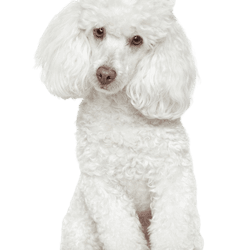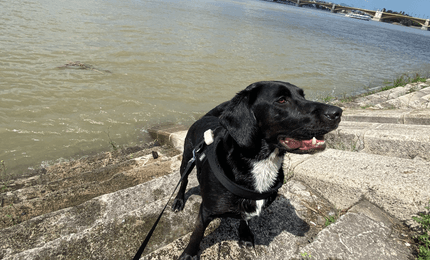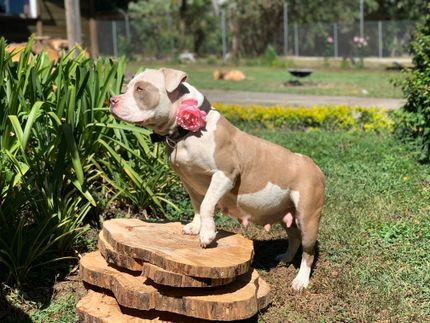Facts & Origin
Chesa-Poo - The charming mix of Chesapeake Bay Retriever and Poodle.
The Chesa-Poo is a fascinating hybrid dog created by crossing the Chesapeake Bay Retriever and the Poodle. This unique blend combines the characteristics of both breeds to create a versatile and intelligent companion dog.
Suitability and Husbandry
The Chesa-Poo is ideal for families and individuals looking for an active and loyal companion. With his energy and intelligence, he is a good fit for people who enjoy spending time outdoors and can challenge him mentally and physically.
| Alternate Name | - |
| Origin | USA - Germany |
| Life expectancy | 10 - 15 years |
| Care requirements | low-maintenance - high-maintenance |
| Activity level | high - average to high |
| FCI group | not recognised |
| AKC group | not recognised |
| KC group | not recognised |
More Chesapeake Bay Retriever mixes
More Poodle mixes
Attitude, character and temperament of the breed
Possible character traits of the Chesa-Poo
The Chesa-Poo often shows the following character traits, which are influenced by its parent breeds:
- Intelligent: He is an extremely intelligent dog that learns quickly and enjoys learning new tasks and tricks.
- Active: The Chesa-Poo needs sufficient exercise and mental stimulation to be happy and balanced. Daily walks, games and mental challenges are important to his well-being.
- Friendly: He is usually friendly, loving and loyal to his family and other pets.
- Protective Instinct: Because of his ancestry from retriever and guard dog breeds, the Chesa-Poo can develop a natural protective instinct and alert his family to certain situations.
The Chesa-Poo is a wonderful companion with a unique combination of traits, charm and versatility. Give him the love, attention and proper care he needs and you will find in him a loyal friend for life.
Usage
Health and diseases
The Chesa-Poo is generally a robust and healthy dog. However, there are some important health issues you should be aware of:
- Hip Dysplasia: As with many larger dog breeds, the Chesa-Poo can be prone to hip dysplasia. Regular veterinary exams and proper exercise are important to promote joint health.
- Eye Problems: Poodles are prone to eye problems such as cataracts or progressive retinal atrophy. It is advisable to have regular eye exams to detect potential problems early.
Care of the Chesa-Poo
Grooming the Chesa-Poo requires regular attention to maintain its coat and health. Here are some important grooming considerations:
- Coat Care: Brush the coat regularly to prevent matting and keep the coat clean and healthy.
- Ear Cleaning: Clean the ears regularly to remove dirt and moisture and minimize the risk of infection.
- Dental Care: Brush his teeth regularly to prevent dental problems.
What does this mixed breed look like?
The Chesa-Poo exhibits a variety of traits inherited from its parent breeds. Here are some characteristic traits you can expect to see in a Chesa-Poo:
- Coat: It can have either a curly or a wavy coat that comes in a variety of colors such as brown, black, beige or silver.
- Size: the size of the Chesa-Poo can vary, but it usually reaches a shoulder height of about 45 to 55 cm.
- Weight: Its weight is usually between 18 and 30 kg.
Known Diseases
Hip dysplasia (HD)
Hip dysplasia (HD) is a genetic condition in dogs where the hip joint is not shaped properly. This leads to pain, stiffness and restricted movement.
Elbow dysplasia (ED)
Elbow joint dysplasia is a chronic disease complex of the elbow joint of fast growing dog breeds.
Epilepsy
Definition: Dog has epilepsy if, for example, at least two epileptic seizures occur more than 24 hours apart.
Cataract
Cataracts are still one of the most common causes of blindness, even in dogs.
Progressive Retinal Atrophy (PRA)
Progressive retinal atrophy (PRA) is a slowly progressive death of the retina in dogs.
Patellar problems
Problems with the Patellar can be a displacement or weak kneecap, which is one of the most common causes of lameness in dogs, also because of overweight.
Eye diseases
Often occur with allergies and intolerances.
FAQ
-
The size of a mongrel can vary, but they are usually medium-sized and reach a shoulder height between 45 and 56 centimeters.
-
This mixed breed can have a range of different colors, from golden or silver fur to black or chocolate gray.
-
Most of these mixed breeds are very active and intelligent. They will usually get along well with other pets and people. They are also easily trainable and attentive.
-
Because of their two breeds of origin, these mixed lings love to swim and refresh themselves in the water.
-
These mixed breeds require good regular grooming, including bathing, brushing and periodic combing.





















